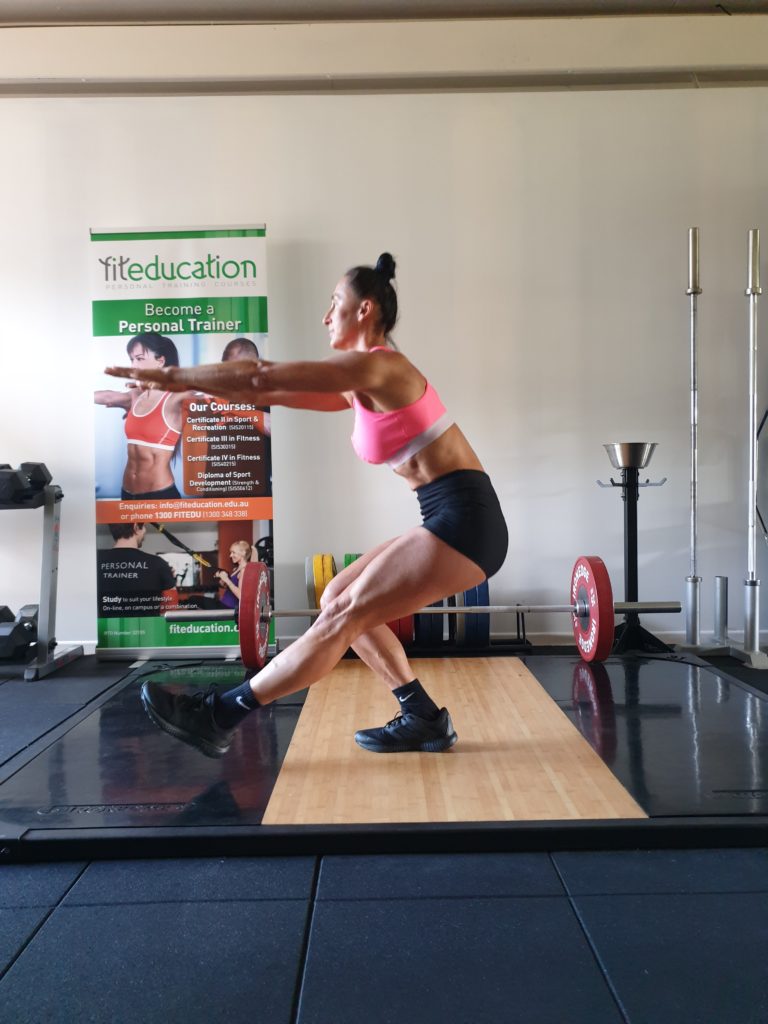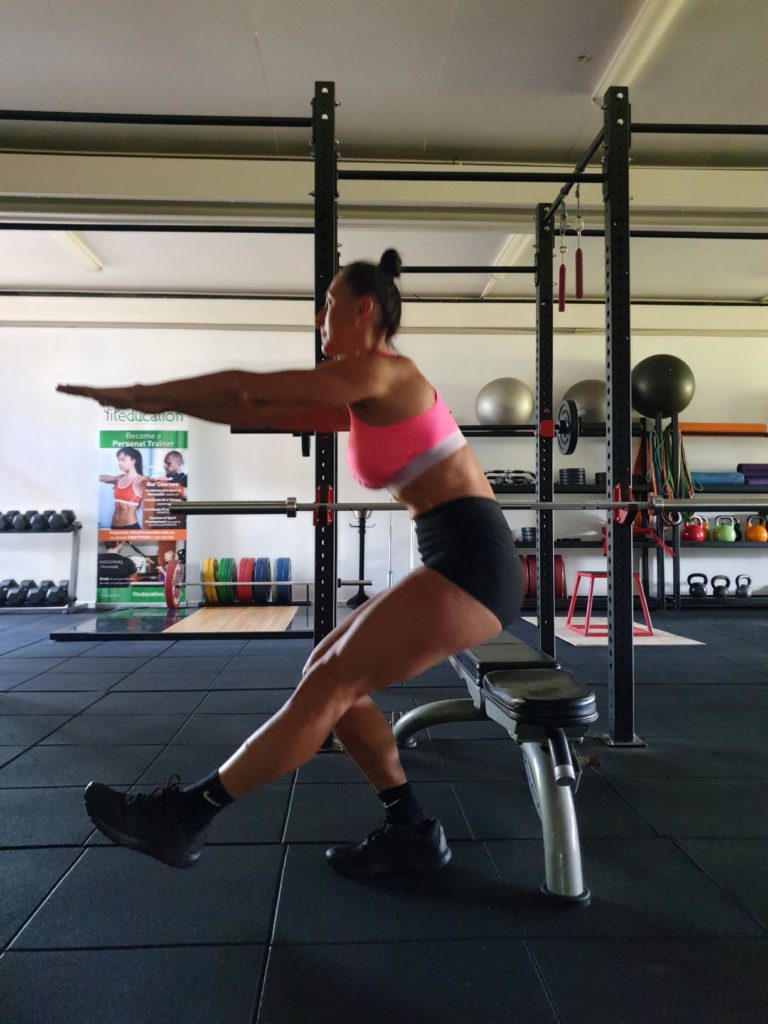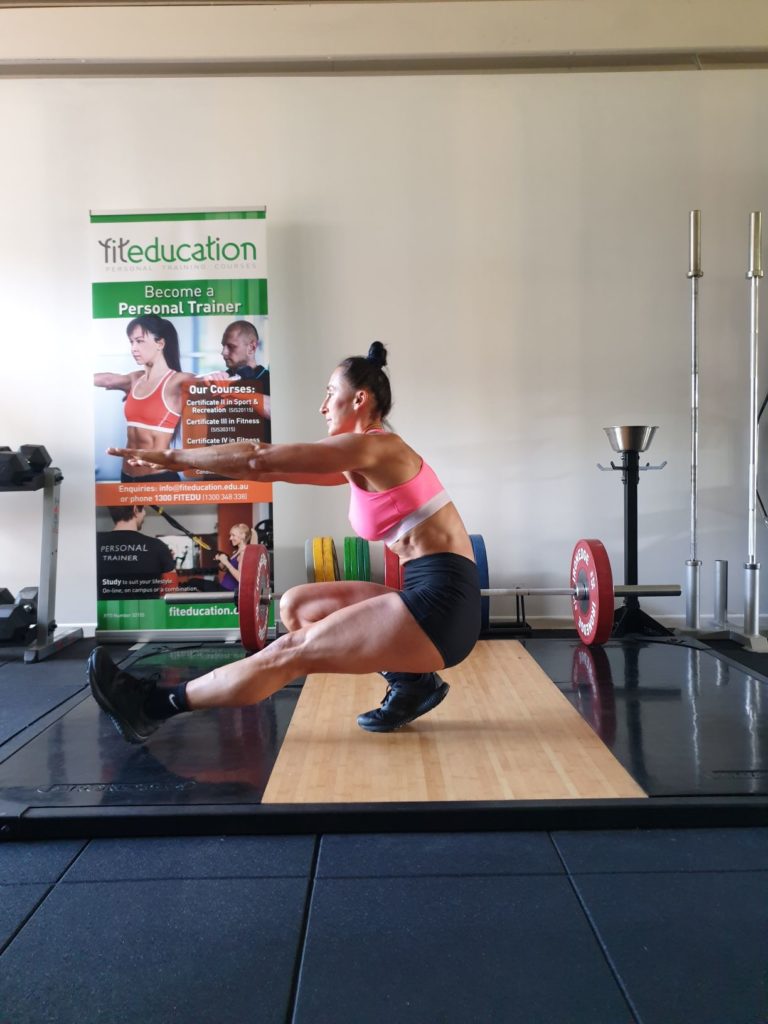The squat is one of the great exercises. It stimulates all the major muscles in the legs – the quads, hamstrings and glutes. The single-leg version aids balance, mobility, co-ordination and core stability. It also allows participants to focus on maintaining a straight back (neutral spine), which articulates great benefits into other exercises. The single leg squat is a particularly good one-leg exercise for athletes, as it mimics the movement of running while strengthening the leg muscles, and is great for pre-habilitation / rehabilitation. Single Leg Squats also aid in eliminating strength imbalances between the left and right leg, and improving knee stability.
Stand on one foot with the other leg bent at the knee. Once balanced on one leg, squat down as low as possible without losing form (or toppling over). Try not to let the knee go past the front of the toes while squatting. Pause at the bottom of the squat for a second, then push back up through the heel, and squeezing the glutes.
In this video 2 x progressions are demonstrated: 1) Single leg squat standing on a box 2) Pistol squat.
Single Leg Squat – Muscles Used
Agonist muscles
(Prime movers) Gluteus maximus ; Quadriceps: Rectus femoris, vastus lateralis, vastus medialis, vastus intermedius
Synergist muscles
Abdominals, erector spinae (spinalis, longissimus, iliocostalis), gluteus medius, gluteus minimus, quadratus lumborum, adductors, gastrocnemius, fibularis longus & brevis, soleus
Joint movements
Hip- Flexion (downward phase); Extension (upward phase)
Knee- Flexion (downward phase); Extension (upward phase)
Step-by-Step Instructions
- Stand on one leg with your foot pointing straight ahead and the knee of the other leg slightly bent. You can have your arms extended for balance or kept at your sides. Roll your shoulder blades back and keep your back straight. Keep your weight centered over the ball of your foot, your upper body erect, and your head facing forward.
- Raise the non-supporting foot from the floor slightly.
- Lower to a squat position, keeping the knee of the supporting leg centered over the ball of the foot. Start with shallow squats and progress with depth.
- Maintain neutral spine, chest up and knee aligned over the ankle.
- Repeat for 10 squats on each leg. Aim for three sets.

Common Mistakes
- Back rounds and forward hunch lowering into the squat
This is often caused by poor ankle mobility. Try placing a weight plate under the heel. Be sure to prioritize ankle mobility training to permanently correct the problem.
- Knee caves inward
Technically called valgus collapse, this puts stress on the knee. It’s usually caused by a lack of glute strength or activation—especially the gluteus medius—which makes it difficult for the hip to control the upper leg and stabilize the knee. Try some Monster Walks to strengthen the lateral hip muscles.
- Not squatting through a full range of motion
Solid part of the way down and then the form drops. This isn’t as much of a mistake as it is a strength / flexibility limitation. Try some box squats. Increase the height of the box by adding pads or plates, or using a taller box. Get stronger in this range and then lower the height of the box.
Single Leg Squat Variations
- Single Leg Balance
Balancing on one leg until you can stand on one leg for 30 seconds. By starting with this exercise, you will start to develop the smaller stabilizing muscles. You will find your balance improves over time.
- Single Leg Exercise Ball Squat
Squat against the wall with an exercise ball between the back and the wall. This will provide additional stability.
- Single Leg Box Squat
Step 1: Position a knee-high box behind you. Stand on the right leg.
Step 2: Sit the hips back and bend the knee to lower into the squat and simultaneously raise the arms up to counterbalance. Keep the back flat, chest up and knee aligned over the ankle.
Step 3: Continue lowering until the butt touches the box . At this point, the arms should be in front of the shoulders and parallel to the ground. Do not rest on the box.
Step 4: Drive through the foot and straighten the knee and hips to stand up to the starting position. Repeat with the opposite leg.

- Weighted Single Leg Squat
Perform a single-leg goblet squat by holding a dumbbell or kettlebell in the hands. Or, hold a dumbbell in each hand.
- Pistol Squat
The pistol squat is a more difficult variation in which the leg is extended in front as the participant squats through full depth.

Check out these other resistance training exercises:
- Face Pull
- Bench Press
- Turkish Get Up
- Front Squat.
- Shoulder Press – Standing Barbell
- Deadbug – Abdominal Exercise
- Monster Walk
- Overhead Squat
- Battle Rope
- Goblet Squat
- Swiss Ball Hamstring Curl
- Seated Cable Row
- Ab Roller
Learn more about resistance training the Certificate III in Fitness, Certificate IV in Fitness,and Diploma of Fitness Courses.
